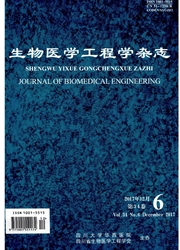

 中文摘要:
中文摘要:
越来越多的医疗设备能采集人体不同特征数据并形成三维图像。在临床应用中,通常需要将多幅含有不同重要信息的源图像融合到一幅图像中以辅助治疗。而传统的图像融合方法主要针对二维图像,这些方法直接应用于三维数据会导致第三维信息的损失。本文结合近期出现的超小波变换——三维带限剪切波变换和四组传统融合准则,提出新的三维磁共振图像融合方法。最后通过四组人脑T2*和磁量图(QSM)源数据,将本文的方法分别与基于二维和三维的小波、双树复数小波的融合方法进行对比。实验显示基于三维变换的融合方法性能普遍优于基于二维变换的方法;三维方法中,剪切波克服了传统小波变换缺乏表达方向的缺陷,能有效地提高传统图像融合算法的性能,因此,本文的方法质量指标最高。
 英文摘要:
英文摘要:
More and more medical devices can capture different features of human body and form three dimensional(3D)images.In clinical applications,usually it is required to fuse multiple source images containing different and crucial information into one for the purpose of assisting medical treatment.However,traditional image fusion methods are normally designed for two dimensional(2D)images and will lead to loss of the third dimensional information if directly applied to 3Ddata.Therefore,a novel 3Dmagnetic image fusion method was proposed based on the combination of newly invented beyond wavelet transform,called 3Dband limited shearlet transformand(BLST),and four groups of traditional fusion rules.The proposed method was then compared with the 2Dand 3Dwavelet and dual-tree complex wavelet transform fusion methods through 4groups of human brain T2*and quantitative susceptibility mapping(QSM)images.The experiments indicated that the performance of the method based on 3Dtransform was generally superior to the existing methods based on 2Dtransform.Taking advantage of direction representation,shearlet transform could effectively improve the performance of conventional fusion method based on 3Dtransform.It is well concluded,therefore,that the proposed method is the best among the methods based on 2Dand 3Dtransforms.
 同期刊论文项目
同期刊论文项目
 同项目期刊论文
同项目期刊论文
 期刊信息
期刊信息
